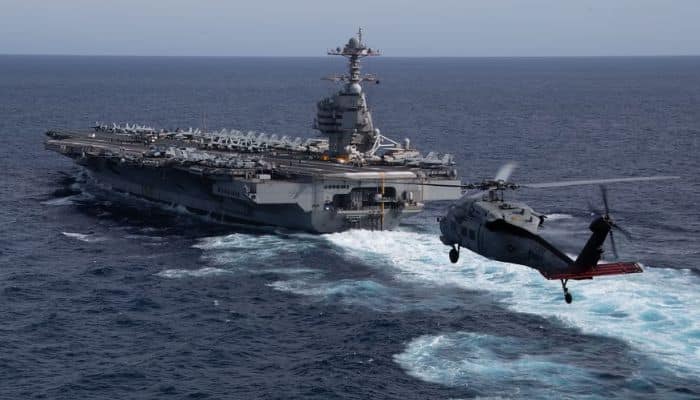
A new updated CRS report dated 5 August 2024 is out on the USS Ford debacle.
I read these reports so you don’t have to.
For plenty of reasons, the carrier is the crossbow and chariot of the 21st century. Yet the US insists on spending tens of billions of dollars on these obsolete and antiquated exquisite platforms that are more vulnerable now than ship at sea in the history of mankind.
Of course, the US is building five of these proven failures. Let’s do easy math and suspend our disbelief and price these colossal strategic blunders at 20 billion each for procurement but inflation and projections of the last ship rolling into the ocean in FY2030 will surely stretch that number north.
20 billion times five equals 100 billion dollars. That’s just to buy the ship and if the Ford is any indicator, many hundreds of millions will have to be allotted to fix what is, in the end, a severely flawed ship design embracing a mid twentieth century concept that is now a military anachronism.
Here’s the procurement breakdown:
CVN-78 (Gerald R. Ford) was procured in FY2008. The ship was commissioned into service on July 22, 2017, and achieved initial operational capability in December 2021. The ship’s first deployment began in October 2022, more than five years after the ship was commissioned into service.
CVN-79 (John F. Kennedy) was procured in FY2013. The Navy’s FY2025 budget submission states that the ship is scheduled for delivery in July 2025.
CVN-80 (Enterprise) was procured in FY2018. On April 2, 2024, the Navy announced delays in the scheduled deliveries of several of its shipbuilding programs, including CVN-80, whose delivery, the Navy stated, will be delayed approximately 18 to 26 months. The Navy’s FY2025 budget submission, which was submitted to Congress in March 2024, shows the ship’s scheduled
delivery date as September 2029, or 18 months later than the March 2028 date shown in the Navy’s FY2024 budget submission, which was submitted to Congress in March 2023.CVN-81 (Doris Miller) is treated in this report as a ship that was procured in FY2019, consistent with congressional action on the Navy’s FY2019 budget. (The Navy’s FY2025 budget submission, like its FY2021-FY2024 submissions, shows CVN-81 as a ship that was procured in FY2020.) The ship is scheduled for delivery to the Navy in February 2032.
CVN-82, as noted above, is programmed for procurement in FY2030 under the Navy’s FY2025 budget submission. Procuring CVN-82 two years earlier, in FY2028, could involve providing roughly $550 million in AP funding for the ship in FY2025.
CVN-80 and CVN-81 were procured under a two-ship block buy contract that was authorized by Section 121(a)(2) of the John S. McCain National Defense Authorization Act for Fiscal Year 2019 (H.R. 5515/P.L. 115-232 of August 13, 2018). The use of the two-ship block buy contract reduced the combined estimated procurement cost of the two ships.
You will also note that it took five years after being commissioned before it was deployed.
Five years.
And they certified its deployment status without completing the necessary cyber survivability tests nor the usual shock testing of the Total Ship Survivability Trial (TSST):
The CVN 78 Total Ship Survivability Trial (TSST) has been delayed by approximately one year, until 4QFY24 [fourth quarter of FY2024], due to the ship’s deployment being earlier than planned. The TSST is an onboard, extensive damage-control test to demonstrate how the ship design enables the crew to perform its recoverability-related procedures. For the CVN 78 TSST to be adequate, the testing will require at-sea execution with participation of an embarked air wing. Planning is ongoing to ensure that this adequacy requirement is met.
In 1QFY24, the Navy intends to publish two vulnerability assessment reports (VARs) examining the class’s survivability against above-water and underwater kinetic threats. These reports will include findings from survivability testing and modeling of the ship conducted since 2007. However, these reports as drafted do not accurately model the ship as built and do not include findings from more recent testing. Without updating the models, the analysis in the VARs will not support conclusions on the survivability of the CVN 78 class against threat weapons. The Navy intends to issue a final survivability assessment report that will include the findings from recent testing and update model-based survivability analysis by 4QFY25. If the survivability modeling and simulation (M&S) is updated to accurately model the ship as built, this assessment will support DOT&E’s report on the survivability of the class against threat weapons.
Please note, they deployed a new carrier with an embarked air wing in operational status in 2022 and has not completed its survivability tests which it claims will be the last quarter of 2025, three years after deployment. This is like a new car on the market that has not been safety tested and certified but declared safe and road-worthy.
Despite alleged cost caps for the Ford at 11.5 billion it has quickly exceeded that to balloon to 20 billion plus when all is said and done. Are these the teething pains of a new class of exquisite platform costs, that is possible but the history shows the costs continue to rise upwards. An analyst with more time than me can look at all the promises since 2008 of how much the Ford carrier will cost and consistently underestimate the true cost.
One final note, an aircraft carrier has one job: launch and retrieve aircraft otherwise it is useless. The Electromagnetic Aerial Launch System (EMALS) has been a reliability disaster, to wit.
During FY23, DOT&E observed EMALS reliability remained consistent with recent developmental test (460 mean cycles between operational mission failures (MCBOMF) in FY21 and 614 MCBOMF in FY22).
In order to leave the deck with a naval jet aircraft, the combination of full military power and the catapult assigns the necessary physical loft to get it off the deck and airborne. The failure of the EMALS puts that aviator in the hazard for not getting the loft and ditching the aircraft in the sea (hence the offset of the launch deck so the ship steaming forward doesn’t run over the plane in the drink). That means in combat with sortie generation (number of planes cycled aloft), that is a number that will be on the minds of every naval aviator queued up to be rocketed off the deck.
Withe the nearly century-old steam catapult technology used on all carrier classes before the Ford, the MCBOMF was approx 1:35,000.
I urge you to read the report.
Stop building these things!
Navy Ford (CVN-78) Class Aircraft Carrier Program: Background and Issues for Congress 5 August 2024
Email me at cgpodcast@pm.me.






























